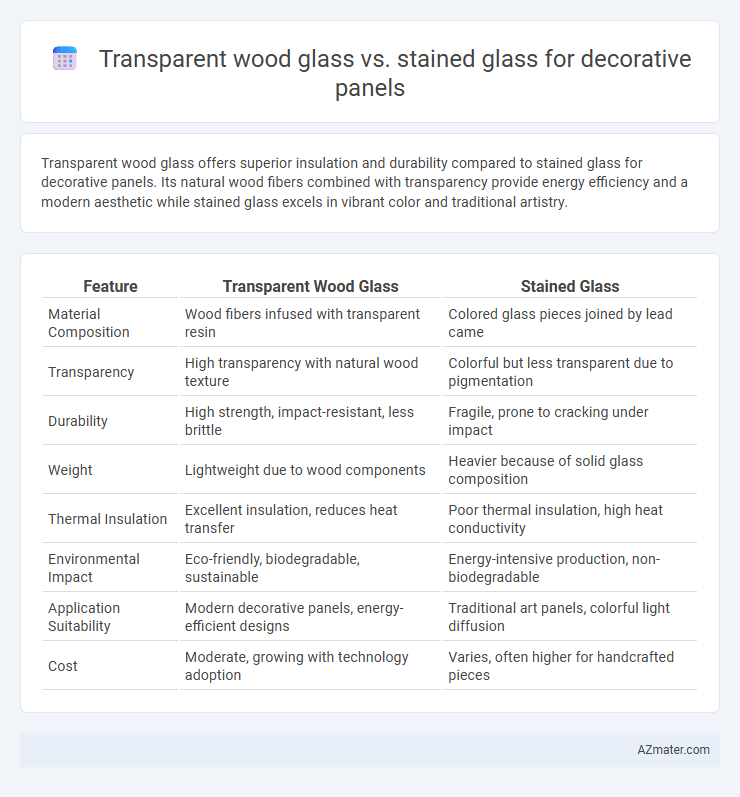Transparent wood glass offers superior insulation and durability compared to stained glass for decorative panels. Its natural wood fibers combined with transparency provide energy efficiency and a modern aesthetic while stained glass excels in vibrant color and traditional artistry.
Table of Comparison
| Feature | Transparent Wood Glass | Stained Glass |
|---|---|---|
| Material Composition | Wood fibers infused with transparent resin | Colored glass pieces joined by lead came |
| Transparency | High transparency with natural wood texture | Colorful but less transparent due to pigmentation |
| Durability | High strength, impact-resistant, less brittle | Fragile, prone to cracking under impact |
| Weight | Lightweight due to wood components | Heavier because of solid glass composition |
| Thermal Insulation | Excellent insulation, reduces heat transfer | Poor thermal insulation, high heat conductivity |
| Environmental Impact | Eco-friendly, biodegradable, sustainable | Energy-intensive production, non-biodegradable |
| Application Suitability | Modern decorative panels, energy-efficient designs | Traditional art panels, colorful light diffusion |
| Cost | Moderate, growing with technology adoption | Varies, often higher for handcrafted pieces |
Introduction: The Rise of Alternative Decorative Panels
Transparent wood glass offers superior durability and enhanced insulation compared to traditional stained glass, making it an emerging favorite in modern decorative panels. Its unique combination of natural wood fibers and transparency provides a lightweight, shatter-resistant alternative that maintains aesthetic appeal and energy efficiency. Stained glass remains valued for vibrant color expression and intricate designs, but transparent wood glass is gaining traction due to its eco-friendly properties and versatility in contemporary architectural applications.
What is Transparent Wood Glass?
Transparent wood glass is an innovative material created by removing lignin from natural wood and infiltrating it with a transparent polymer, resulting in strong, lightweight panels with excellent light diffusion and thermal insulation properties. Compared to traditional stained glass, which is made from colored glass pieces fused together to create decorative designs, transparent wood glass offers enhanced durability, sustainability, and energy efficiency. Its unique combination of natural wood texture and translucency makes it ideal for modern decorative panels seeking both aesthetic appeal and functional performance.
Understanding Stained Glass: A Timeless Craft
Stained glass, crafted by fusing colored glass pieces through lead came or copper foil techniques, has been a timeless decorative panel choice for centuries. Its intricate designs and rich hues create vibrant visual narratives that capture and filter natural light, transforming interiors with a classic, artistic ambiance. Unlike transparent wood glass, stained glass offers unparalleled customization in color and pattern, preserving historical artistry while enhancing aesthetic appeal in architectural spaces.
Visual Aesthetics: Transparency vs. Vibrancy
Transparent wood glass offers a modern, sleek look with high transparency that enhances natural lighting and preserves subtle wood grain textures, creating a warm and airy ambiance. Stained glass provides vibrant, rich colors and intricate patterns that cast dynamic, colorful light reflections, adding artistic depth and a historic charm to decorative panels. Choosing between the two depends on whether the design prioritizes clear visibility and light diffusion or bold, colorful aesthetics with intricate detailing.
Durability and Longevity Comparison
Transparent wood glass offers superior durability compared to stained glass, as it is more resistant to cracking, shattering, and UV degradation due to its composite structure of wood fibers and polymer resin. Its longevity spans several decades with minimal maintenance, while stained glass, though visually striking, is prone to brittle failures and requires regular upkeep to prevent lead came corrosion and glass deterioration. Transparent wood's enhanced mechanical strength and weather resistance make it a long-lasting alternative for decorative panels in both interior and exterior applications.
Energy Efficiency and Insulation Properties
Transparent wood glass offers superior thermal insulation due to its high strength-to-weight ratio and low thermal conductivity, enhancing energy efficiency in decorative panels by reducing heat transfer. Stained glass, while visually appealing, has poorer insulation properties because traditional glass conducts heat more readily, leading to higher energy loss. Incorporating transparent wood glass in panels improves indoor temperature regulation and lowers heating and cooling costs compared to stained glass.
Sustainability: Eco-Friendliness of Each Material
Transparent wood glass offers superior sustainability due to its renewable timber base combined with high light transmission, reducing energy consumption for lighting. Stained glass, traditionally made from glass and metal oxides, involves higher energy usage and resource-intensive production processes, increasing its environmental footprint. Choosing transparent wood glass promotes eco-friendliness by utilizing biodegradable materials and offering better thermal insulation, thereby enhancing energy efficiency in decorative panels.
Design Flexibility and Customization Options
Transparent wood glass offers superior design flexibility with its ability to be shaped, tinted, and textured to mimic natural wood grain while allowing light transmission, providing a unique aesthetic not achievable with stained glass. Stained glass features vibrant color customization through handcrafted patterns and intricate lead came or copper foil construction, but it remains limited to flat-panel designs and traditional motifs. Both materials enable creative expression, but transparent wood glass excels in customizable light diffusion and modern architectural applications.
Maintenance and Cleaning Requirements
Transparent wood glass offers superior durability with low maintenance, requiring only occasional dusting and gentle cleaning with a mild, non-abrasive solution to preserve its clarity and finish. Stained glass demands more careful upkeep as it is prone to scratching and discoloration, often needing specialized cleaning agents and techniques to maintain its vibrant colors and intricate details. Both materials benefit from regular inspection to prevent long-term damage, but transparent wood glass provides a more user-friendly, resilient option for decorative panels.
Cost Analysis: Investment and Long-Term Value
Transparent wood glass panels typically require higher initial investment due to specialized manufacturing processes but offer superior durability and energy efficiency, reducing maintenance and replacement costs over time. Stained glass panels have lower upfront costs but may demand frequent restoration and are prone to fragility, increasing long-term expenses. Evaluating transparent wood glass versus stained glass from a cost perspective reveals transparent wood as a more cost-effective option with greater long-term value for decorative panels.

Infographic: Transparent wood glass vs Stained glass for Decorative panel
 azmater.com
azmater.com